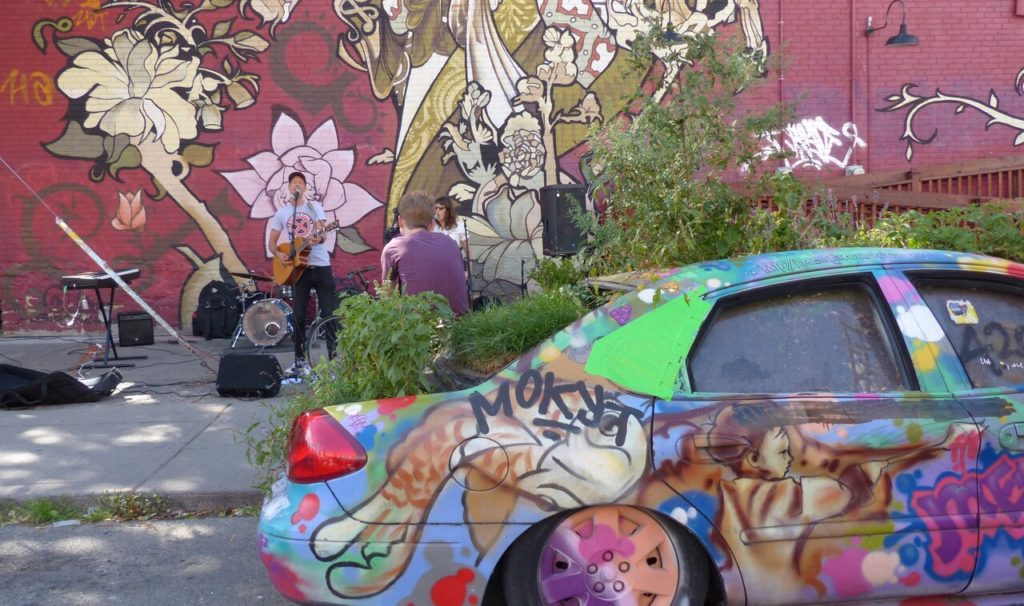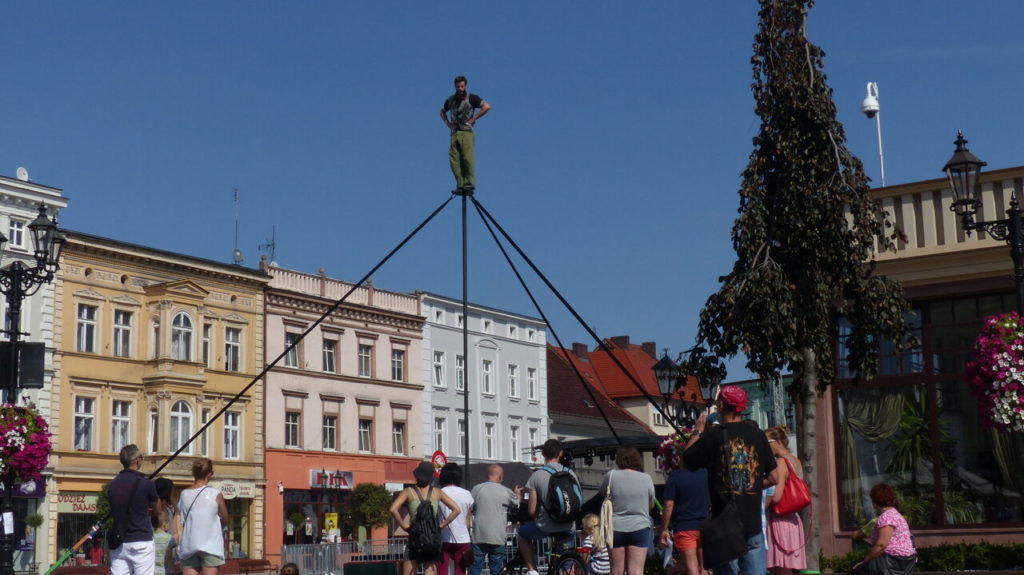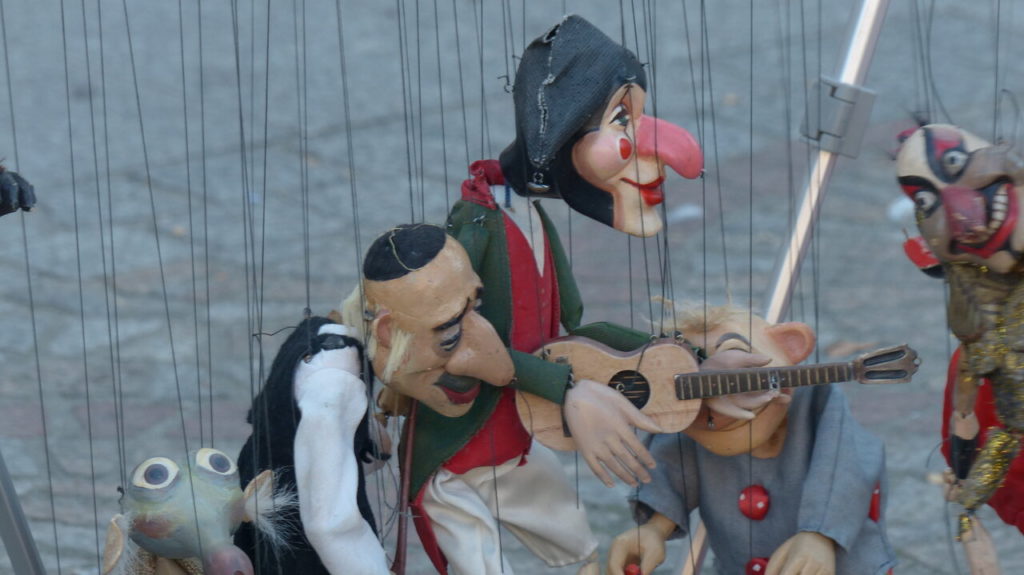
In this article, I share tips on making a street show promo video that sells your act. To give you a better perspective, I have also included feedback from my fellow busking festival organisers.
This article is part of my series on marketing strategy for street performers and how to prepare your busking festival application. Don’t forget to check my posts on how to write a street promo text and artist bio and choose content for your website.
What the festival organisers want to see in your promo video
Your promo video is like a movie trailer. It shows the viewers what they might expect when they come to see you. Your goal is to explain your show, build excitement and make organisers want to book you and introduce you to their festivals’ audience.
What makes a good promo? First things first, it provides festival organisers all the info that they need:
- Act’s genre
- Condensed plot summary
- Your disciplines, skills, techniques and props/instruments
- A glimpse of your personality/stage persona
- Your interaction with the audience/ if you engage volunteers
- Show structure
- Show mood.
Promo video for the audience vs for the organisers
More and more often buskers’ promo videos look like music video clips. A lot is happening, we can see many visual effects and fast cutting, and there is a popular song as a soundtrack. They are packed with action, but there is a problem – they don’t explain what the show is about and what skills the performer has.
Facebook cover or 15-second ad for people scrolling their social media feed require different editing than a video for your festival applications. Catchy content works on social media when we promote the line-up and need to draw people in, but not during the selection process.
Have your target audience in mind
Tobias Hundertpfund from the event agency Zeitenwanderer: “Some videos are made super professional, they are movieART, so I would like to have the contact details of the video makers in case I need one, but it shows me too little of the artist and the show. An application video has to be honest. Music overlay over the entire video and then maybe cut quickly – it can be a fatal choice. (…) Often an uncut smartphone video from a visitor shows me more than a highly professional one“.
Your video should convince the organisers who watch hundreds of promos that they should select you over similar acts. You want to prove that you are a street performer with a unique and exciting show, and someone they want to work with.
Honza Šinko, Pilsen Busking Fest: “When I look at the application, to select someone I must have a feeling that the artist looks responsible and is a kind person. A promo video should be from the regular street show. Better video/audio quality also helps. I’m looking for a good atmosphere – it says that a live show must be great.”
Why is your video so fast (aka is your skill real)?
Promo videos should be short, but that doesn’t mean that each scene must be brief. Provide some show excerpts longer than a second or two.
Thanks to computer effects, we can convince audiences of the skills we don’t have. Did you know that Even Dooley Wilson, who played Sam in “Casablanca” was faking it when he played “As Time Goes By”? Or that Lola Kirke of “Mozart in the Jungle” didn’t know how to play the oboe?
Actors playing musicians sometimes need to learn enough notes for a two-second shot.
A professional editor can trick us that everyone can be a juggler, saxophone player, or a magician.
How to make a person who doesn’t know any magic trick look like a pro? Step 1: A quick explanation of how to pose and hold the props. Step 2: editing: two seconds of a logo, 3 seconds of showing faces of the public, 2 seconds of rolling coins, 3 seconds of people clapping, then zoom on cards, again people are cheering, zoom on props, and so on. Add a loud audio track with a fast tempo, and some visual effects.
A video promoting street performance should show skills of a busker over skills of video editor and camera operator.

Tips for making a street show promo video
Start with a plan and a script
Make notes before you turn on the camera. Write down:
- The goal of your video and your target group
- What do you want your audience to see, and how do you want them to feel?
- The must-have moments to capture
- Location – will you use shots from your street show (one or multiple locations) or other places?
- Who will film you?
Have in mind all the questions I mentioned earlier and how you want to provide all your show information.
Make sure that a camera operator understands your performance and what you are best at. Asking for help from someone who knows your show by heart, e.g. another street artist with whom you often share spots or a friend who often accompanies you, can bring better results than hiring someone who can come to your show once and who has never seen a street theatre before.
Create a sense of a story
The narrative of the videos is often confusing. The sequences of scenes should be logical.
Street festivals are not sports competitions. It is not about who throws diabolo higher and juggle more balls.
Don’t confuse the viewers with random shots sequences. You have to build a story just like you would on the street. What happens before and after you throw these balls in the air? Show us the context.
Don’t try to include too many ideas
Show highlights but don’t give everything away.
Prioritise what you want to reveal. Display a variety of routines to keep it interesting, but don’t overwhelm with information.
Showcase your talent and selling points
Same like with promo text, videos of street performers are often almost identical with repetitive numbers. Find a way to stand out.
Tobias Hundertpfund explains: “I think half (or more) of all the applications we receive are comedy with juggling. Our job when selecting applicants is to find the subtle differences, to choose the five most special, different, best ones from 250 (or more) comedy juggling videos.”.
Don’t waste too much time on common street show elements like choosing the prettiest girl to throw you torches. Write down what you believe is unique about you and your performance. Are you a master in crowd building? Have you nailed a trick that required months of training? Do you have any signature numbers?
Tricks are not the only things you can show in your video. You can include footage from your preparation, building custom-made props, transferring yourself into your stage persona, interaction with your audience after your performance, etc. Maybe it’s your costume, suitcase or haircut that makes you memorable?
Find the right pacing
Simplify your shots. Determine the length based on how much information it conveys. Help the viewers understand what is in the frame. Maybe they have never seen your trick, and won’t understand it. It takes time for people to absorb new information. After watching your promo, everyone should be able to tell what your show is about. Avoid making it so fast that it’s impossible to follow.
The pacing should vary to help you create the atmosphere. You have to decide which shots have the most impact. Show moving images longer than the static ones.
Each scene should have a purpose. Often the master shots will make more sense when you display your skills and tricks than editing.
Keep it short
Tobias explains: “We receive about 500 applications and we take a lot of time for the selection process. But in the very first selection round, we can’t invest more than about 3 minutes in a video. If it is much longer, we randomly select excerpts. A good application video should tell everything necessary in 1,5 up to 3 minutes.“
You want to share as much as possible, but a promo video is a trailer, not a whole show. Put yourself into your audience’s shoes. Would you invest time in watching this video? Think about how to tell your story concisely. You don’t want people to scroll through or exit the video and miss your best moments.
Live up to your promises
Promo shouldn’t give a misleading representation of your show.
Display tricks and numbers that your audience will see live. For example, if you shoot your aerial acrobatic stunts indoors, don’t choose the numbers you don’t perform in the street. If you apply as a solo artist, don’t send videos with your group compilations. It’s impossible to imagine how your show would look without three other entertainers.
Don’t steal the footage
Use the video material that you have the right to use. If someone (e.g. media or festivals) uploaded videos of your performance, it doesn’t mean that you can download them and edit freely.
Review and refine
Take a break before you watch your video again (and again). Don’t edit it at once and watch it many times. Remove repetitive scenes. If you feel it’s boring, others will think that too.
Showing the crowd and evoking emotions
Creating emotions and connecting with the public is part of the show, but Tobias and I have different opinions on the importance of showing the audience’s reactions.
I need to see the audience’s reaction…
Tobias Hundertpfund: “Audience reactions are a very good way of assessing the energy and quality of a show. I like to see your (!) audience and their reactions. If a large auditorium freaks out, there will be good reason for it – definitely a plus. If you send me a video that shows you and your tricks, your comedy, but without any audience or without showing the audience, it is difficult to judge whether the show will work well in front of an audience. I can’t see: can you get the people’s attention? Are the jokes working?“.
…versus it feels like canned laughter
When watching a video, I often feel that scenes with the audience are there because someone thought they are necessary.
There is a difference between showing how you involve the volunteers and showing the crowd’s enthusiasm.
If your show is highly improvised or based on interactions with the audience, your video won’t make much sense without showing how you activate the public. However, there are performances when the audience doesn’t play a big part (e.g. puppet theatres, fire shows). In this case, the focus should be on the skills and storyline. The round of applause after a show will be more than enough to prove that people enjoyed it.
I’ve seen many promos based on audience reactions – people clapped and burst into tears, but I didn’t learn why. I prefer it when someone tells me a joke, so I can decide if it would work for my festival’s audience. If the scenes showing enthusiasm are repetitive or lengthy, it falls into telling, not showing, which I explained in my article about writing a promo text. When overused, it feels like canned laughter.
Make sure the scenes of reactions look natural, e.g. one shot shows both a trick and an audience’s response.
I don’t look for big crowds when watching the videos. It’s a busker’s promo, not a festival’s promo. Many performers who are not buskers, but perform at street festivals, feel lost when they don’t have a big crowd waiting for them, so a crowd doesn’t tell me if someone is a good busker, or many people were attending a festival where the footage was filmed.
And the last thing about showing the audience. Please, be careful with close shots of children without their parents’ permission. They may want to protect their privacy.
How to make organisers that look for different things happy? Keep a balance of what you show.

Music for your promo video
Background music sets the tone of the video, but it doesn’t always work to your advantage.
Tobias points out also that music changes the perception of the video too much: “It’s okay to round off a video with subtle music at one point or another. But when the music gets out of hand, or a video contains only off-music and no original sound, I tend to watch the video without the sound. Why? Because film scores work. They do their trick, and they distort the impression! When you put Rammstein music over a video, it inevitably gets energy and speed. Completely different than when you use calm classical music. But I want to judge the energy of your show, not Rammstein’s energy.“.
Tips for selecting the music
Don’t use the most popular buskers’ songs
Have you heard of “music torture”? Don’t force people to mute your video by choosing one of the most repetitive songs in buskers’ promos: “I Will Survive”, Eye of the Tiger”, “The Final Countdown”, “Spitfire”, “Chariots of Fire”, “Guilty”, and everything by Abba.
You want to use a song that everyone knows and loves, but don’t forget that some other performers are doing the same and usually in the same context (e.g. Amelie’s soundtrack for contact juggling).
Use original audio
Let us hear your voice. Keep at least some original audio, mostly when you talk during your show. It gives a better picture of your performance and allows us to get to know you better. Don’t hide behind the music. If you talk a lot during your show, a promo without your voice is like showing a live recording of a music band with muted vocals.
Choose music you are allowed to use
Choose music that you have rights to use. When you add a copyrighted song without obtaining permission, you risk that YouTube will mute your video or close down your account. Copyrights owner can also run ads on your video or, in the worst scenario, sue you.
Royalty-free music from online libraries will usually be a cheaper and less complicated option. Royalty-free doesn’t mean that it’s for free. In most of the cases using a track requires obtaining a license or at least attribution. You can find audio that you can use without credits or a fee, but your options will be limited. You may also consider public domain music (music which copyright has expired),
If you are a performing artist, your show promo video is for commercial purposes, so keep it in mind when selecting a license.
Music should reflect the mood of your show
Music must fit your content; otherwise, it will be distracting. A lyrical story and a comedy act need a track of different tempo. Joyful music significantly magnifies the judgment of joy of a sad film sequence.
If you use vocals, the lyrics should match the visuals, so instrumental music is a safer option.
Wrapping up
Your promo video’s goal is to get you booked, so when selecting one for your application, have festival and event producers, not TikTok followers in mind.
Festival organisers want to see your skills, get a glimpse of your personality, and understand your show’s plot. Show your performance’s highlights in a proper sequence. Go easy with special effects – you don’t need aerial filming with drones to showcase your talent. Focus on creating an engaging story as you do when you perform in the street.
What has worked for you? Do you have a promo video you are proud of? Share your tips and link in a comment section!
Many thanks to Tobias Hundertpfund (Zeitenwanderer) and Honza Šinko (Pilsen Busking Fest) for their contribution.
